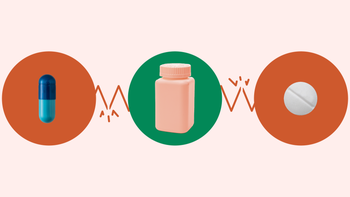
What Is a Pulmonary Embolism (Blood Clot in the Lungs)? Symptoms and Risk Factors
Key takeaways:
A pulmonary embolism (PE) is a blood clot in the lungs. Usually, these clots form in the legs, break off and travel through the blood vessels, and then get stuck in the lungs.
Common symptoms of a PE are chest pain (particularly during a deep breath), shortness of breath, lightheadedness, and a fast heart rate.
Certain conditions put you at risk of getting a PE. These include blood clotting disorders, cancer, recent surgery, long periods of immobilization, and pregnancy.

A pulmonary embolism (PE) is a blood clot in the lungs. Blood clots can form in any blood vessel in the body. But they tend to form in the deep veins in the legs. Sometimes, a piece of the clot can break loose. When this happens, the clot can travel through the veins and circulate with the blood. It tends to get stuck when it reaches the lungs, where the blood vessels naturally branch off into smaller vessels.
PEs aren’t common. But they can be serious, especially if the blood clot is large. It can interfere with blood flow in the lungs. Also, it can significantly impact the heart’s ability to function. So it’s important to diagnose a PE before it causes more serious problems.
Here, we’ll talk about symptoms of PEs, risk factors, and diagnosis.
Symptoms of a pulmonary embolism
The symptoms of a PE can vary from person to person. Some people have severe chest pain. This can happen when the lung doesn’t get enough blood flow. Other people may not have any chest pain — but they notice mild weakness or dizziness. And others may only notice swelling in their legs — which can be due to the blood clot or a change in their heart function.
This is all to say that there’s no way to diagnose a PE on symptoms alone. But some of the more common symptoms include:
Chest pain: When a PE causes chest pain, it often feels like a sharp, focused pain that worsens when you take a deep breath. But others may experience this as a dull pain or tightness in the chest.
Shortness of breath: This develops when the blood clot prevents the lungs from getting oxygen into the blood. Some people with a PE feel short of breath all the time. Others only notice it with activity, like when walking up steps.
Lightheadedness or fainting: This can happen if the blood clot lowers your blood pressure. Low oxygen levels also contribute.
Bloody cough: This can occur if the blood clot irritates blood vessels in the lungs. Other conditions can also cause this symptom. But with a PE you might see small specks of blood when coughing.
Fast pulse: The heart tends to beat faster when there’s a blood clot in the lungs, so you might feel like your heart is racing.
Can deep vein thrombosis (DVT) be cured? These common treatments for DVT are helpful in managing the condition.
What does DVT feel like? Three people share their journey with DVT and the symptoms they experienced.
Leg cramps don’t always indicate DVT. Learn about other causes, like medications and dehydration.a
PEs often come from a deep vein thrombosis (DVT) in the legs. So, some people may have symptoms of a blood clot in one of their legs. These symptoms might be pain, swelling, tenderness, and/or redness of the leg.
It’s important to be able to recognize the signs and symptoms of DVT and PE so you can seek help quickly.
Quiz: Do I have DVT?
Causes of pulmonary embolism
Blood clots are often a normal response to bleeding. It’s your body’s way of preventing too much blood loss. But sometimes blood clots can form where or when they shouldn’t. Or they might not break down like they’re supposed to.
There are many reasons for this. Some medical conditions affect how quickly the blood clots. Other conditions cause the blood to pool in the veins, which makes it more likely to clot. These are considered risk factors, because they make a condition more likely to happen. Anything that affects the blood clotting process or causes blood to be stagnant inside the veins can increase the risk for PE.
Risk factors for pulmonary embolism
You’re at increased risk for PEs if your blood clots more readily than normal. This is called a “hypercoagulable state.” Some things that cause this are:
Inherited blood clotting disorders, like factor V Leiden
Cancer
Liver disease
Some autoimmune conditions, like antiphospholipid syndrome
Some types of birth control or hormone treatment
Pregnancy
Areas of decreased blood flow can also lead to blood clots. Blood cells are more likely to stick together and clot when blood pools in a vein instead of flowing through it. Things that can cause this include:
Immobilization: When muscles contract, they help squeeze blood through the veins. When you don’t move, your muscles don’t help with blood flow.
Surgery: You’re often less active after surgery, which puts you at risk of blood clots. This is especially true after a joint surgery, like a knee or hip replacement.
Long travel time: Sitting on a plane for several hours at a time can increase your risk. This is more likely to happen if you’re at risk for blood clots for other reasons.
Venous insufficiency: This is a condition in which valves in the veins that stop blood from flowing backward don’t work as well, leading to blood pooling in the legs.
Diagnosis of a pulmonary embolism
The diagnosis of a PE starts with your signs and symptoms. A PE is a rare diagnosis, and testing can be time consuming. So healthcare professionals make sure there’s a good reason to suspect a PE, before they put you through any unnecessary testing or expose you to radiation.
If you’re experiencing some of the above symptoms, your healthcare team will start by looking for more clues that you could have a PE. These include things like your:
Age
Other medical conditions
Risk factors for a PE
Vital signs (like heart rate and oxygen level)
Signs of a DVT on a physical exam
If you’re at low risk for a PE and there are no other clues pointing toward the diagnosis, this may be enough to rule out the diagnosis without doing extensive testing.
Tests for pulmonary embolism
When the cause of your symptoms is less clear, testing can be helpful. These tests aren’t necessary for a diagnosis. But they may be helpful to your clinical team when trying to find reasons or rule them out:
D-dimer test: This is a blood test that looks at the way your blood is clotting. A low D-dimer means you probably don’t have a blood clot. A higher D-dimer doesn’t necessarily mean you have a PE. Rather, it just means you need more testing.
Other blood tests: Additional lab work may include oxygen level, blood cell counts, and proteins that can indicate heart trouble.
Chest X-ray: This gives a good picture of the health of your lungs. It can’t diagnose a PE. But it might find a different cause of your symptoms, like pneumonia.
Electrocardiogram (EKG): This noninvasive test looks at the rhythm and electrical signals of your heart. It’s a common test for someone with chest pain or pressure.
Ultrasound: This is a noninvasive way to look at the blood flow in your leg(s), so it might detect a blood clot.
If your healthcare team has good reason to think you might have a PE, or if your D-dimer is elevated, there are two main ways to confirm a diagnosis of PE:
CT scan of the chest: This is a 3D X-ray of the arteries that lead to the lungs. It’s performed with contrast dye through an intravenous (IV) line, which outlines any blood clots in the lungs.
Ventilation-perfusion scan: During this test, you inhale a special substance that lights up the lungs. It also requires contrast through an IV to light up the blood vessels. Then a machine scans the lungs to look for areas where there’s a mismatch between blood flow and air supply. Mismatched areas suggest a blood clot.
Treatment for pulmonary embolism
The main treatment for PE is anticoagulant medications (“blood thinners”), which stop the clot from getting bigger. This allows your body to get rid of the clot. Common anticoagulant medication options are:
Direct-acting oral anticoagulants, like apixaban (Eliquis) and rivaroxaban (Xarelto)
Warfarin (Coumadin)
Lovenox (enoxaparin), if you’re pregnant
In some cases, more powerful medications or a procedure is needed to break up the clot. But these treatments are only needed in more serious cases. Most people with a PE won’t need these.
Frequently asked questions
This depends on many things, including how large the clot is and how it’s affecting your heart. It can be fatal within hours, but it’s not always fatal. For example, 10% to 30% of PEs cause death within the first month.
Some steps you can take include quitting smoking (or never starting) and getting regular exercise. If you have a medical condition that makes you more likely to have blood clots, your healthcare team will work with you to lower that risk as much as possible.
And if you have to be sedentary for long periods of time (due to travel or illness, for example), try to move around, wear compression stockings, and/or do gentle leg exercises frequently.
It’s possible for a small clot to go away on its own. But when a PE is causing signs or symptoms, it’s best to get treatment for it right away.
The bottom line
A PE is a serious medical condition, and it can be life-threatening without treatment. The classic symptoms are shortness of breath and pain in the chest when you take a deep breath. But everyone’s symptoms are different, which can make diagnosis tricky. If you’re having symptoms of a PE, don’t delay medical care. This is especially true if you have any underlying conditions that increase your risk of blood clots.
Why trust our experts?



References
American Lung Association. (2024). Learn about pulmonary embolism.
American Lung Association. (2024). Pulmonary embolism symptoms and diagnosis.
American Thoracic Society. (2018). Pulmonary embolism.
Anand, S. S. (2017). Smoking: A dual pathogen for arterial and venous thrombosis. Circulation.
Centers for Disease Control and Prevention. (2025). Data and statistics on venous thromboembolism.
Hitos, K., et al. (2022). Effect of leg exercises on popliteal venous blood flow during prolonged immobility of seated subjects: Implications for prevention of travel‐related deep vein thrombosis. Journal of Thrombosis and Haemostasis.
MedlinePlus. (2023). Blood clots.
MedlinePlus. (2023). Factor V Leiden thrombophilia.
Obradovic, S., et al. (2022). The timing of death in acute pulmonary embolism patients regarding the mortality risk stratification at admission to hospital. European Heart Journal.
Your Vascular Health. (n.d.). Pulmonary embolism.

























